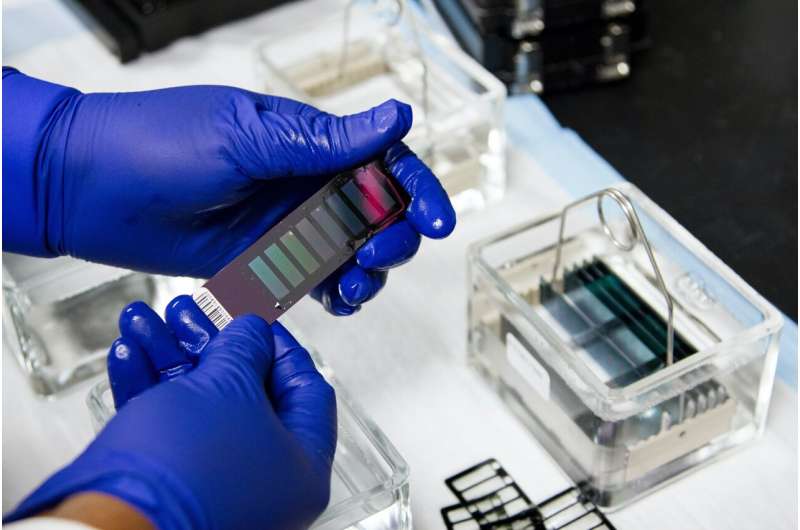This article has been reviewed according to Science X's editorial process and policies. Editors have highlighted the following attributes while ensuring the content's credibility:
fact-checked
peer-reviewed publication
trusted source
proofread
Identification of genetic drivers for esophageal cancer creates new opportunity for screening, treatment

Esophageal adenocarcinoma (EAC) is a highly lethal cancer, with a five-year survival rate of less than 20%. Although a precursor lesion to EAC, called Barrett's esophagus (BE), is present in roughly 7% of middle-aged adults, less than 1% of BE patients will progress to EAC, making it difficult to determine which individuals are at risk of developing this deadly cancer.
To better understand why only a small fraction of individuals with BE develop EAC, investigators from the Mass General Cancer Center, a member of the Mass General Brigham health care system, used genomic databases to identify genetic drivers associated with EAC.
Their results, published in Gastroenterology, highlight that 9% of EAC patients harbor mutations in cancer-predisposing genes, shedding light on the causes of progression to the disease and new possibilities for screening and treatment.
"The development of EAC was previously thought of as a 'bad luck' phenomenon, so we were stunned to find cancer-predisposing mutations in esophageal cancer patients at such a high rate," said corresponding author Manish Gala, MD, of the Division of Gastroenterology at Massachusetts General Hospital (MGH).
"To put that into perspective, the prevalence of such mutations is 7–10% in pancreatic adenocarcinoma, and genetic testing has been recommended for all individuals diagnosed with this cancer. Given the similar prevalence in EAC, universal genetic testing should be considered for this cancer as well."
Notably, the researchers found that EAC patients with cancer-predisposing mutations had developed EAC across the age spectrum, implying that simply having a mutation did not trigger EAC; rather, BE and other environmental factors are likely additional prerequisites for cancer. Still, findings suggest that these "germline" cancer-predisposing mutations, which are present at conception and therefore found in every cell of a patient, may accelerate genomic instability that increases the likelihood of progression from BE to EAC.
This study was based on genomic data from 640 individuals with EAC, pooled from public U.S. and U.K. databases. A total of 59 patients had highly rare, cancer-predisposing germline mutations, most commonly in the ATM gene. To validate these results, the researchers also analyzed nearly 300 individuals from MGH cohorts who either had EAC or BE with high-grade dysplasia (a precursor to EAC), BE without cancer progression after 10 or more years, or who were healthy nonagenarians.
Again, they found that germline mutations, especially in the ATM gene, were the most prevalent in EAC patients, with evidence that in people who progressed to EAC, there may be additional epigenetic changes that cause abnormalities in ATM expression compared to non-progressors.
Results from the study also shed light on the existing question of why approximately 30% of EAC patients do not have a common cancer-causing mutation, a TP53 mutation, "within" their tumor cells. The researchers found that EAC patients "without" TP53 mutations in their tumors were instead much more likely to have pathogenic germline mutations, and at a rate comparable to that of ovarian cancer, which is known to be a highly genetics-dependent disease.
Collectively, results support the idea that genetic testing can help risk-stratify EAC patients, due to the important role germline mutations appear to play in triggering progression from BE to EAC.
Going forward, the researchers plan to derive estimates of EAC risk based on gene-specific mutations, a task that will require larger study cohorts. Furthermore, they are using their knowledge of the germline mutations common in EAC (such as ATM mutations) to repurpose existing therapies that may be useful for treating EAC, with two drug candidates already identified.
"The key takeaway from this study is that if someone is progressing toward EAC from BE, performing genetic testing is probably warranted," Gala said. "For people who already know they have a mutation, we will still need more data to figure out how to best care for these individuals, but a one-size-fits-all approach to screening may not be appropriate."
More information: Minyi Lee et al, Germline Determinants of Esophageal Adenocarcinoma, Gastroenterology (2023). DOI: 10.1053/j.gastro.2023.07.015


















